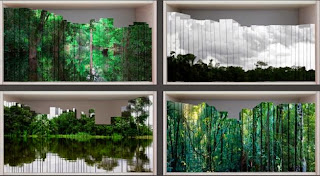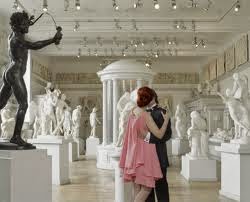I haven't attended degree shows since I started art writing so thought I would change that this year. The first two were Central St Martin's and Westminster University - the two couldn't be more different. Read on for my top picks:
This is a vast show as you'd expect from an arts institute of this pedigree. The number of artists on display meant it had the feel of an art fair - with all the pros and cons that come with it.
It guarantees that I'd like at least some works but the art overload meant that pieces that require reflection, are abstract or slow building (especially applicable to video art) often failed to grab my attention in the few seconds I had for an initial glance.
First to grab my eye was Helen Saunders' 'still life videos'. The abandoned yet serene scenery she's captured has a melancholic beauty to it. Yes it is a video and subtle, the irony of my views in the previous paragraph are not lost on me.
Shinji Toya's booth challenges the nature of art. By asking a computer to randomly generate an abstract image, it questions whether abstract art created by humans should have any more intrinsic value. A similar theme to that raised by the Outside Art exhibition at the Wellcome Collection.
Tanya Tier's sense of humour also appealed to me - a giant hammer on a chain is linked to a panel that says break in case of emergency. The futility of the work brings to mind all the nonsensical signs we encounter in everyday life.
Mette Hammer Juhl has produced a playful series where everyday objects are transformed into fountains. It's fun but is also an attempt to bring something magical into an often mundane world.
Light has been a growing influence in the art world, and art students have also been experimenting with it. There were some particularly strong works featuring light here.
Louise Beer's pulsating strobe lights in a dark room are an intense experience, only matched by Olafur Eliasson's fountains in the Hayward Gallery's Light Show. You can only bear it for a few minutes but the light appears to jump out of you and it leaves you feeling disoriented.
My favourite work of the exhibition was by YuLong Wang. It's a combination of laser light and what I assumed to be dry ice to create a primordial soup of shifting shapes in the vapour. By encouraging visitors to blow on it, creates rippling light effects that are captivating.
You will have noticed traditional painters are lacking in my highlights and I was disappointed by the lack of any cutting edge painters - particularly in representational works. The one painter that stood out was Marianne Morild for her use of bitumen to give her work a depth and weight that would normally require lots of layering of paints. The splashes of colour gave this work a Fiona Rae-esque feel to it.
This exhibition couldn't be more different to the above and I preferred its layout. It utilised the cavernous space of the Ambika P3 to display works that were neatly spaced out, giving them room to breathe.
This meant we had less works on offer and only two works stood out for me.
Kostas Synodis plays with our views on the solidity of walls by having a clamp appear to compress a wall and pipe pass straight through another. Here's an earlier work of a similar ilk:
As well being humorous it also makes the viewer feel at unease. Plaster walls are always seen as safe and reliable, we lean with our full body weight upon them and think nothing of it. This artwork makes us rethink whether we should be so trusting.
Nabeelah Moosun has mocked up a chamber akin to those used to handle radioactive materials. Gloves on each side allow visitors to handle the objects inside and you expect there to be something dangerous inside, but there's nothing within the sheets or beneath the cardboard. This anti-climax spoke to me of the nanny state and the culture of fear that we're surrounded by.











+%C2%A9+NASA+ESA+J.+Hester+and+A.+Loll+(Arizona+State+University).jpg)











